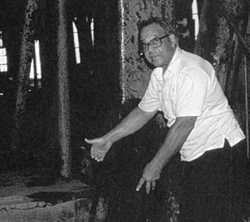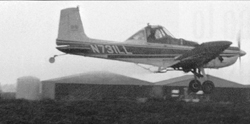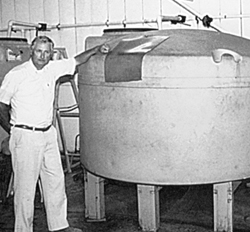Introduction to Delta Pieces: Northeast Louisiana Folklife
Map: Cultural Micro-Regions of the Delta, Northeast Louisiana

The Louisiana Delta: Land of Rivers








Ethnic Groups










Working in the Delta








Homemaking in the Delta



Worshiping in the Delta



Making Music in the Delta




Playing in the Delta







Telling Stories in the Delta



Delta Archival Materials
Bibliography

Working in the Delta
By Susan Roach
Dictator and definer of the Delta, the Mississippi River provides the fertile flood plain that makes possible the majority of traditional, regional occupations in this predominantly rural area. Now open and flat with blurred timber on the horizon, the Delta landscape with its resources of rich "buckshot" dirt, waterways, timber, and gas features farming- and river-related occupations, which exhibit a complex of techniques, customs, and modes of expressive behavior typical of occupational folklife: raising cotton, soybeans, rice, cattle, and catfish; crop dusting; commercial fishing; lock operations; and riverboat work. Floods, chemicals from the air and water, insects from mosquitoes to boll weevils, dangerous, expensive technology, and debt all pose risks to life and livelihood and are echoed in Delta occupational narratives.
The river itself gave rise to major occupations such as riverboat work and river and flood control. Riverboat work—earlier on steamboats and on today's towboats—has always required a wealth of informally learned occupational knowledge: of complex, traditional jargon and operating techniques associated with the river; of specific boats and their parts; of duties of each job; and of riverboat crafts. For example, a deckhand makes a "possum"—a braided rope bumper—to cushion the boat when it docks or ties up to a lock wall. Sometimes living on the boat for thirty days at a time, riverboat workers also share stories, songs, and jokes about river work (Sandmel 1990:10-11). Lock and dam operators, who maintain appropriate water levels in river channels, may share riverboat lore and learn much of their job traditionally.

Because of the threats of flooding and malaria, the flat, rich flood plain along the Mississippi and its tributaries came to settlement and farming later than the adjacent areas. Termed buckshot because it dried into hard black pellets—and gumbo when it was wet, because of its stickiness—Delta topsoil, laid down by centuries of flooding, was "such perfect soil for raising cotton that people considered it worth the risk long before flood control was possible" (Bolsterli 1991:5). In the early 19th century Anglo-American pioneer farmers and slaves settled in the river bottoms. Towns became centers for the lumber industry, which riverboats and railroads helped grow, until no virgin timber remained (Whayne and Gatewood 1993:216). Jewish, Syrian, and Lebanese immigrants entered the Delta mainly as peddlers and later became merchants with businesses such as dry goods. To replace slave labor after the Civil War, planters brought in Italian and Chinese workers. After World War II, these groups opened small groceries and restaurants in such Arkansas towns as Helena, Blytheville, Pine Bluff, and Holly Grove; and in Ferriday, Vidalia, and Monroe, Louisiana. Some Irish also came as laborers and tenant farmers and were quickly assimilated. In 1878, Germans from the Midwest came to the Delta and brought their farming technology; one of the larger groups, led by a Lutheran minister, purchased a 7,747-acre plantation near Stuttgart, Arkansas, which would become the center of the Arkansas rice industry (Whayne and Gatewood 1993:153, 165-66).

Worked by slaves before the Civil War and by sharecroppers and paid laborers after the war, large tracts of cotton grew even larger with the advent of mechanized, corporate farms. Delta planters traditionally have taken mainly a supervisory role: giving orders, arranging loans, doing the paperwork, absorbing the profit and loss, risk and worry. However, some planters also grew up working in the fields, plowing, chopping, and picking cotton. Along with their work in the home, many Delta women and children also did farm work. Liddy Aiken, an African-American woman from Wheatly, Arkansas, summed up the work ethic in 1938 when she was sixty-two: "We farm. I done everything could be thought of on a farm. I ploughed some less than five years ago.... I learnt to work. I learnt my boys to go with me to the field and not be ashamed to sweat. It's healthy. They all works" (Whayne and Gatewood 1993:141).
Lake Providence, Louisiana, planter Grady Brown relates the daily routine of his boyhood on his father's Panola cotton plantation and the typical changes wrought on these traditions by growing mechanization:
When we grew up, we were able to walk behind a plow at probably six or seven.... We were tall enough to reach up and hold the handles.... Daddy gave us all a mule and plow and put three or four of us in the field, and we just plowed the same cotton field every day. We had ninety-five tenant families on the farm.... They used to ring a big bell up on the mule barn and all the hands would be at the barn catching their mules.... They all came to work with an old syrup bucket, and that was their dinner. They would carry some peas and what they called hoe cake.... This went on for four or five years, and then the tractors came about the starting of the war, 1942-44, and then we switched over to tractors, and the first year we ... lost forty families. They migrated to Dallas, or Chicago, or California. And when I came home in 1961, we had about twelve or fifteen families living on the farm.
Cotton also generated work in cotton gins, compresses, and crop dusting. Illustrating the importance of versatility and on-the-job learning, John Warner, from Rayville, Louisiana, began as a water boy at a local compress in 1937 and advanced to calling the press from the 1950s to the 1970s, when he was finally named foreman - the first African American in the region to hold the position. Undoubtedly, his promotion to foreman resulted from his twenty years as the press caller, when he would shout instructions and sing blues work songs to pace the monotonous yet dangerous activity of the compress. These songs were patterned after the work songs from the cotton fields and prison chain gangs. Warner recounts the typical learning process of such jobs: "The older men - they'll watch you and they find out you want to do different things. They would always take the time out and show you and tell you how to take advantage and how to do certain things." However, the same men might play tricks on inexperienced workers; Warner remembers someone being sent to the office to fetch a cotton saw - a nonexistent tool. Such joking behavior is probably still found around today's computer-operated compresses.

In the early 1900s, mechanization and larger farm acreage turned Delta farmers to a more efficient method of fertilization and pest control - crop dusting, or aerial application, the current professional's term. Having been fascinated by flying in his childhood, Owen Dale Holland and his older brother, from Jonesville, Louisiana, started dusting their own crops and later developed a family crop dusting business. Crop dusters also learn the specialized language concerning equipment, techniques, and the different jobs of their trade in a traditional manner. And they, too, tell and suffer through jokes. A crop duster for forty-two years, Charlie Davis recalls being teased at his wedding about his survival chances: "When we got married, the preacher asked me what did I do. I said I was in crop dusting. He told my wife that the life span of a crop duster was two years."
The public regards crop dusters with some ambivalence. On the one hand, they are "crazy nuts" taking risks and putting poisonous chemicals into the environment. On the other hand, as Arthur Woolson puts it, "You're almost next to God to those farmers when you're dusting those crops because upon your efforts depend his success. If you fail, he fails. If you win, he wins." Holland explains the modern farmer's plight and the complex, symbiotic relationship of the two occupations, justifying why the crop duster is "willing to take a risk":
Most of the people don't understand to begin with why you are aerial applicating. It is simply because they have no background knowledge of farming. They still want to see a farmer in overalls and a pitchfork and a straw hat. Today, with finances and economics, you do now or you don't get it done. You've got to have someone that is qualified to do the job. Farmers are working under a lot of pressure themselves these days. We know that; we have farmed before. And a farmer comes here with that look on his face; you know he is serious. You don't play with him much; you get very serious with him, and you deal with him from that point on because of his problems. When he comes to get the airplane, he's got to have help, and you know that, so you take that into consideration.
Crop dusting, which in Tallulah, Louisiana, grew into Delta Airlines, also is important for soybeans and rice, which diversified Delta farming during World War II. The popularity and higher price of soybeans caused many farmers to plant even more soybeans during the fifties and sixties; this brought heavy dirt-moving machinery operators from the Midwest, including Mennonites, to level the land further. Many Mennonites such as the community near Lake Providence, Louisiana, stayed in the region, thus changing the cultural landscape as well.
While the flattened land eased cultivation and irrigation, it also increased drainage and flood problems. Flooding is a periodic problem in the backwater areas of rivers which run into the Mississippi. Many stories about floods concern destruction of crops, homes, and businesses, and traditions of moving people and livestock to higher ground. Since early farming days, livestock—especially mules and cattle—has been important for the Delta farmer. In some areas range land was open, and livestock even grazed on the levees. However, when floods threatened, local levee boards hired levee guards to watch for drifting debris, water seepage, and sand boils. As an eighteen-year-old guard in 1927, Myles Smith recalls an experience he had one night returning to St. Joseph, Louisiana:
Just as we got into town, a mule had bogged down in this levee right in front of the Masonic Hall, and they was scared the levee was going to break right there, and everybody that could pack a sack was on that levee throwing sacks. I guess that mule's bones are still in that levee. He went down in there, and there was no way to get him out. They just put sacks in there on top of him.... That was a pretty rough night.

Today's farmers still maintain herds of cattle with little open range. Calling themselves ranchers, they manifest typical cowboy culture with some characteristics peculiar to the Delta, such as the use of Catahoula cur dogs for round-ups and herding cattle and free-ranging hogs. Stories about the breed's origins abound in the Delta: one says it is a hybrid of the red wolf and mastiffs brought by DeSoto's Spanish explorers in 1542, another traces the dog to the Natchez Indian tribe.
Traditionally, Delta farmers also risk huge debts - a recurring theme in narratives. As described by Margaret Bolsterli, the Delta plantation's peculiar method of farming after the Civil War was based on "indebtedness:
The landowner borrowed enough money from a bank to make a crop and then lent it to his sharecroppers, most of whom were black, against half the proceeds. He furnished seed, tools, animals to pull the plows, and guarantees of enough money to clothe, feed, and provide medical care for the sharecropper's family until harvest, when the tenant would be obliged to give the landowner half the crop and then, out of his own half, pay back the money he had "drawn" for his and his family's expenses. The owner then would repay the bank for his "furnish" loan. If no money was made, the chain of indebtedness was carried over to the next year (1991:6-7).
Contemporary, often corporately owned plantations still rely on banks to finance expensive farm equipment such as $100,000 cotton combines. Even buying the equipment secondhand at traditional farm-equipment auctions requires financing, according to West Monroe, Louisiana, auctioneer Ike Hamilton; he notes that farmers attending must already have arranged their bank loans before the bidding starts.
Also requiring a huge initial outlay is commercial catfish farming, begun in the 1960s and now flourishing in the Delta. It can cost $200,000 - $300,000 to build and stock eight fifteen-acre ponds, to which must be added an annual feed bill of $150,000. Mississippian Larry Cochran, who farmed the same land as his father and grandfather, gave up row cropping his one thousand acres of cotton and soybeans in 1985 to raise catfish. "I remember my grandfather borrowing eighty thousand dollars at the bank for a year to buy his seed and get a few hundred acres of cotton planted. He could feed both his and my dad's families, and now it costs me sixty thousand dollars a month to feed twenty-three ponds of fish" (Schweid 1992:27).
Catfish farming has had a profound effect on commercial river fishing, which had thrived in earlier decades in the Delta and supplied fish to markets as far north as Chicago. While today's fishermen still brave the dangers of the river, their markets are decreasing, with only small, independent fish markets purchasing their catfish, buffalo, and gar. Traditional river crafts that have survived to support this endangered occupation include net making, often done by women, and boatbuilding. Commercial products and net companies such as the Jonesville, Louisiana, Champlin Net Co., which builds nets to order, have affected these crafts. Some fishermen who still knit their own hoop nets purchase commercial fiberglass hoops instead of making the older-style white oak hoops. Gill and trammel nets are more often purchased today, but wire catfish traps and wood slat traps are still made by fishermen such as Kenneth Hebert, who learned fishing crafts from his grandfather. Representing what is left of the subsistence farmers in the swamps of the Catahoula Lake area, Hebert also raises some wild hogs, hunts, traps, and makes related crafts such as hunting horns for calling dogs.
Throughout the Delta, traditional Southern occupational crafts are sparse, reflecting the massive changes both on water and land. Still, gourd or tiered wooden birdhouses atop tall poles stand near farm buildings to lure purple martins, which eat their weight in mosquitoes every day. While the traditional yeoman farms and the aristocratic plantations have faded along with the steamboat, the water, mosquitoes, fertile soil, risks, and rewards remain.
Works Cited & Suggested Reading
Bolsterli, Margaret Jones. 1991. Born in the Delta. Knoxville: University of Tennessee Press.
Daniel, Pete. 1985. Breaking the Land: The Transformation of Cotton, Tobacco, and Rice Cultures since 1880. Urbana: University of Illinois Press.
Roach, Susan, H. F. Gregory, and Maida Owens. 1994. The Delta Folklife Project: An Overview. In The Louisiana Folklife Festival Program Book. Monroe: Louisiana Folklife Festival.
Sandmel, Ben. 1990. Mississippi River Folklore. In The Louisiana Folklife Festival Program Book. Baton Rouge: Louisiana Folklife Program.
Schweid, Richard. 1992. Catfish and the Delta: Confederate Fish Farming in the Mississippi Delta. Berkeley: Ten Speed Press.
Whayne, Jeannie, and Willard B. Gatewood. 1993. The Arkansas Delta. Fayetteville: University of Arkansas Press.
Suggested Listening
Afro-American Spirituals, Worksongs, and Ballads. Library of Congress Recording AAFSL3.
Blake, Clifford. Cornbread for Your Husband and Biscuits for Your Man: Mr. Clifford Blake, Sr., Calls the Cotton Press. Louisiana Folklife Recording Series 001.
Mississippi Folk Voices. Southern Folklore Record 101.
Negro Folk Songs from the Mississippi State Penitentiary. Tradition TLA 1020.
Negro Work Songs and Calls. Library of Congress Recording AAFSL 8.
Roots of the Blues. Atlantic SD1348.



